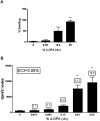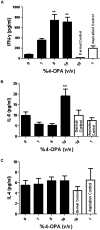Irritancy and allergic responses induced by exposure to the indoor air chemical 4-oxopentanal
- PMID: 22403157
- PMCID: PMC3355310
- DOI: 10.1093/toxsci/kfs102
Irritancy and allergic responses induced by exposure to the indoor air chemical 4-oxopentanal
Abstract
Over the last two decades, there has been an increasing awareness regarding the potential impact of indoor air pollution on human health. People working in an indoor environment often experience symptoms such as eye, nose, and throat irritation. Investigations into these complaints have ascribed the effects, in part, to compounds emitted from building materials, cleaning/consumer products, and indoor chemistry. One suspect indoor air contaminant that has been identified is the dicarbonyl 4-oxopentanal (4-OPA). 4-OPA is generated through the ozonolysis of squalene and several high-volume production compounds that are commonly found indoors. Following preliminary workplace sampling that identified the presence of 4-OPA, these studies examined the inflammatory and allergic responses to 4-OPA following both dermal and pulmonary exposure using a murine model. 4-OPA was tested in a combined local lymph node assay and identified to be an irritant and sensitizer. A Th1-mediated hypersensitivity response was supported by a positive response in the mouse ear swelling test. Pulmonary exposure to 4-OPA caused a significant elevation in nonspecific airway hyperreactivity, increased numbers of lung-associated lymphocytes and neutrophils, and increased interferon-γ production by lung-associated lymph nodes. These results suggest that both dermal and pulmonary exposure to 4-OPA may elicit irritant and allergic responses and may help to explain some of the adverse health effects associated with poor indoor air quality.
Figures






References
-
- Anderson SE, Ham JE, Munson AE. Irritancy and sensitization potential of glyoxylic acid. J. Immunotoxicol. 2008;5:93–98. - PubMed
-
- Anderson SE, Wells JR, Fedorowicz A, Butterworth LF, Meade BJ, Munson AE. Evaluation of the contact and respiratory sensitization potential of volatile organic compounds generated by simulated indoor air chemistry. Toxicol. Sci. 2007;97:355–363. - PubMed
-
- Arey J, Obermeyer G, Aschmann SM, Chattopadhyay S, Cusick RD, Atkinson R. Dicarbonyl products of the OH radical-initiated reaction of a series of aromatic hydrocarbons. Environ. Sci. Technol. 2009;43:683–689. - PubMed
-
- Arif AA, Shah SM. Association between personal exposure to volatile organic compounds and asthma among US adult population. Int. Arch. Occup. Environ. Health. 2007;80:711–719. - PubMed
Publication types
MeSH terms
Substances
Grants and funding
LinkOut - more resources
Full Text Sources
Medical

